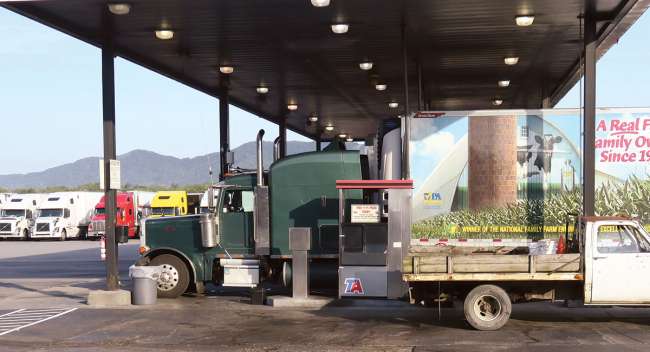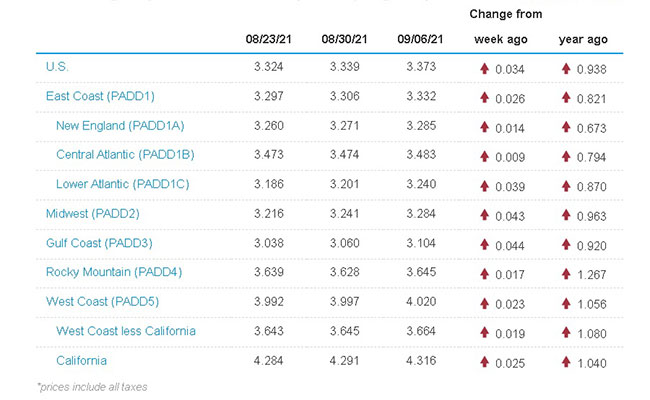Senior Reporter
Diesel Rises 3.4¢ to $3.373 a Gallon

[Stay on top of transportation news: Get TTNews in your inbox.]
The national average price for diesel climbed 3.4 cents to $3.373 a gallon, according to Energy Information Administration data for the week ending Sept. 6.
Diesel has risen in two straight weeks, totaling 4.9 cents a gallon, after dropping in four of the previous five weeks.
Trucking’s main fuel now costs 93.8 cents more a gallon than it did at this time in 2020.
The average price increased in all 10 regions in EIA’s weekly survey. The highest rise was 4.4 cents in the storm-ravaged Gulf Coast area. The smallest increase was nine-tenths of a cent in the Central Atlantic.
Gasoline took a slightly bigger leap, spurting 3.7 cents a gallon on the national average from $3.139 to $3.176.

EIA.gov
More than 10 days after Hurricane Ida slammed into the Gulf Coast, the region’s critical petroleum refinery industry is still struggling to repair and recover from the Category 4 storm that struck land on Aug. 29.
According to the federal Bureau of Safety and Environmental Enforcement, which regulates and monitors offshore oil and gas operators in the Gulf as they return to platforms and rigs after the storm, nearly 78% of the region’s offshore oil production is still shut down and 79 production platforms remain unoccupied.
The offshore U.S. Gulf of Mexico wells are responsible for an estimated 1.8 million barrels of oil per day, 17% of the daily U.S. total, and 5% of the country’s natural gas production.
As of Sept. 8, more than 17.5 million barrels of oil have been lost by the lack of production and it’s possible an equal amount of oil may not be pumped, pushing the total to well over 30 million barrels of oil that may be lost because of the extended shutdown.
According to the Bureau of Safety and Environmental Enforcement, operators have restored less than 25%, or about 400,000 barrels, of daily oil production.
Hurricane Ida is proving to be one of the most damaging storms to the energy industry in 20 years.
“It’s Katrina-like in terms of getting the oil production back online,” Oil Price Information Service Founder and industry analyst Tom Kloza told Transport Topics. “The good news is we’re coming out of season on gasoline, but diesel, with refining capacity being down, you miss the opportunity to build the diesel stocks. I think it’s going to go up and may make a move on $3.50 a gallon for diesel.”

Kloza
Kloza points out that the oil and natural gas industry is larger in the region than 16 years ago when Katrina struck New Orleans with devastating effects after the levees broke. In 2005, the industry produced 1.5 million barrels a day of oil, and now output is 20% higher at 1.8 million barrels per day.
The damage at Port Fourchon, where Ida made landfall, is expected to take weeks to fix. The area is a critical shore base that services platforms in the Gulf of Mexico with special equipment, helipads and pipelines.
One of the biggest oil operators in the Gulf Coast, BP, said it plans to resume full operations in the region once it’s safe “across the supply chain.” The company continues to make repairs at its Port Fourchon facility and has temporarily relocated its shore base operations to Galveston, Texas, and its heliport operations to Lafayette, La.
The shutdowns of the offshore platforms are reducing the availability of certain types of crude oil that refineries need to restart their operations. The Biden administration said it would tap the Strategic Petroleum Reserve and allow Exxon to take 1.5 million barrels of oil to help the energy company resume operations at its Baton Rouge, La., facility.
Kloza said one of the biggest challenges the oil producers are facing is the lack of electric power. “You can’t run a refinery without power,” he said. The situation is improving, albeit slowly.
The state’s biggest electric power provider, Entergy, said on Sept. 8 that about 430,000 customers were still without power — a 61% improvement from the 1.1 million who were without power in the first hours after the storm. The energy company has brought in thousands of workers from other utilities across the country to rebuild its heavily damaged power system.
Want more news? Listen to today's daily briefing below or go here for more info:


